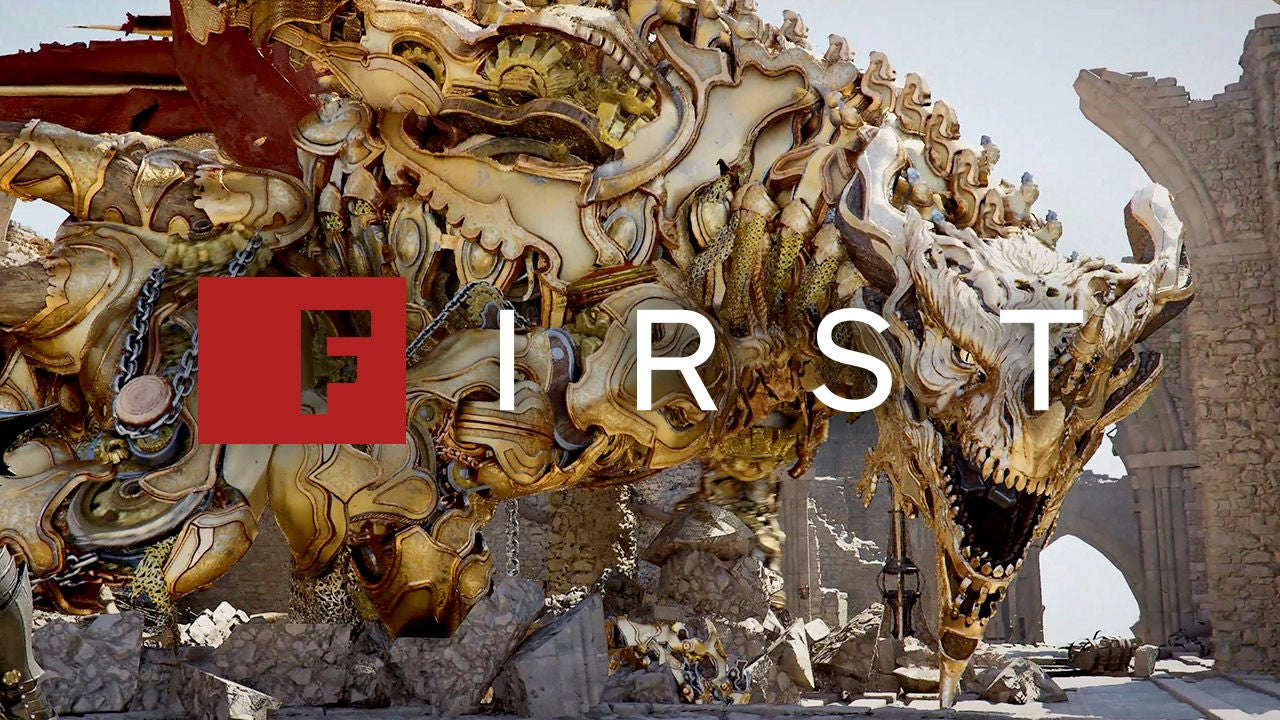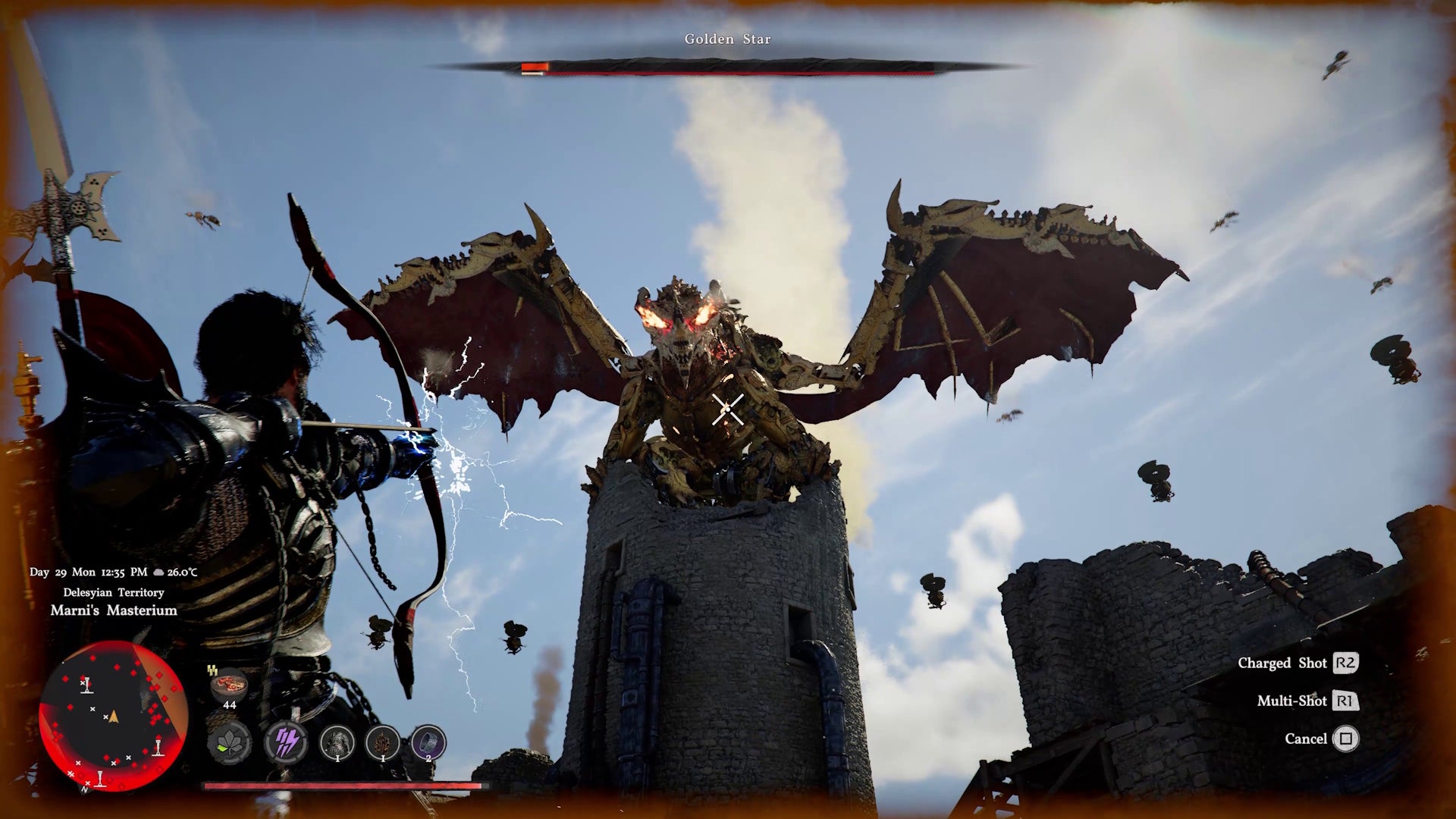

Bosses are woven into the fabric of Crimson Desert’s world. Judging by the many, many different ones we’ve now seen across multiple hands-on demos and videos, it appears that they’re frequently a showstopping spectacle that puts all of your abilities to the test. One such headline attraction is Golden Star, a monstrous mechanical dragon that we fought at the Seoul offices of developer Pearl Abyss in preparation for this month’s IGN First. If you watched our last gameplay video, you’ll have already seen this mighty boss in action, but here we’re going to take you behind the scenes to show you how it was designed, all the way from the sound of its beating wings to the method of its downfall.
It’s safe to say that Crimson Desert’s continent of Pywel offers classic fantasy with a twist, often blending unexpected elements into the mix, including (but not limited to) rideable dinosaurs and supercharged mechs. The Golden Star, with its combination of classic fantasy beast and sci-fi metallic sheen, is this philosophy personified. Members of the Pearl Abyss design team explained that they’d put a lot of focus into trying to blend the organic and the mechanical together, but as part of that, perhaps surprisingly, they also wanted there to be a level of believability. The art team noted that, even though Golden Star looks like a sci-fi dragon, a lot of the materials used in its character model were inspired by everyday materials that could be found not just in modern times, but even back in the more fantasy-adjacent Middle Ages. It’s an approach Pearl Abyss applied not only to the Golden Star, but also to all the robots, industrial buildings, and steam trains that you can find in the game. While these elements lean closer towards science fiction, the design team was insistent on maintaining a sense of believability.
All this helps us buy into the idea that this is a beast that could have genuinely been constructed by Marni, the inventor who sends you out on a quest to battle Golden Star. Exploring Marni’s office in the run-up to this encounter further educates us on the dragon’s origin, as the room is littered with paperwork concerning its construction, as well as industrial machinery that foreshadows the beast’s mechanical nature.
When you finally meet Golden Star, whose claws crumble age-old masonry with ease, you can clearly see how the machine mimics the organic. The Crimson Desert design team made sure that the gears and chains beneath its armoured shell “realistically” operate in unison. Together, these components take the shape of something you’ve never quite seen before, but simultaneously it also feels familiar — the beast’s swooping golden wings and earth-shaking roar can’t help but conjure up memories of Bioshock Infinite’s Songbird, an equally impressive mechanical invention that’s also a man-made creation engineered from a fantasy framework.
The sounds generated by Golden Star presented the team with a very specific challenge: having to combine the organic motions of a winged beast with the mechanical clanks and whirrs of something man-made in nature. On our visit to Pearl Abyss’ South Korean headquarters, we were shown around its purpose-built Foley recording studio and given a walkthrough of all of these different elements, and an insight into the enjoyably explorative process.
First on the agenda was the flapping of its wings, which also became the basis for all other dragons in the game. While Golden Star is mechanical, you’ll notice that its wings are giant sheets of fabric, and so their sound is also created by moving fabric: the waving of a leather jacket. The weathered rustling of the material evokes the sound of a wing’s membrane cutting through the air and provided a solid starting point for how to add aural layers to this creature, with the ultimate goal of creating something previously unheard.
Next up was to give it metallic heft, hence the closing of a creaky, clanking cabinet door being introduced to the mix. It’s followed by a ribbed, plastic hose — the kind you’d normally expect to see at the end of a vacuum cleaner — being pulled along the corner of that cabinet to further add texture to the dragon’s many moving parts. A smaller plastic pipe is then pulled and pushed like an accordion, as this friction, surprisingly, adds an almost cyber-like tone to the beast. It’s this experimentation and commitment to using everyday objects in unexpected ways that make this process look very fun. On top of that, a large fork was dragged along a metal chain while the fingers of an armoured gauntlet were fiddled with at the joints to punctuate the sound of the wings’ smooth motion, providing the effect with a mechanical edge. It all blends into a symphony of noises that creates a soundscape as engineered as the in-game dragon itself.
The Foley studio is just one impressive aspect of the cutting-edge facilities found at Pearl Abyss’ mammoth office building, which also houses a full 3D scanning centre and a performance capture space where many of the game’s cutscenes and combat animations were recorded. I found particular enjoyment in watching my colleague, Matt Purslow, experience the latter for himself, as he stepped into a mocap suit and swung a foam sword around, which was then mirrored in real-time on a neighbouring screen. It’s all very impressive tech, even if Matt could admittedly do with a little weapons training to fully take advantage of it. The pen is mightier than the sword and all that, though.
This tech fuels Pearl Abyss’ creative ambitions, with each boss fight in Crimson Desert not only posing a challenge to the player, but also pushing the limits of the studio’s creativity. The design team wanted to “find out their boundaries and limitations,” and Golden Star presented a particular conundrum due to its sheer bulkiness and ability to fly around at speed. That was very much a problem for a ground-bound, human-sized player to take down. This David vs Goliath effect was desired by the developers, though, who explained that they “wanted to make you feel overwhelmed by the overall size and force of the Golden Star”. To take it down, you’ll need to find its weakness.
As with many of the bosses in Crimson Desert, there is a method to defeat this beast proficiently designed into the encounter, although it’s not the only way to achieve victory, as to incubate that feeling of being able to approach this world’s combat in any way you want to. You can brute force your way through this fight, reading its attack patterns and dealing damage to its gleaming head whenever it rears it. But Golden Star’s true Achilles heel is the power of an EMP blast. Though not strictly a puzzle boss, there are some elements of that style in this fight, such as luring the dragon into breathing fire onto pillars dotted around the arena, which heat up and, in turn, power machines that generate EMP bullets for your arm cannon. Fire enough of these into its body, and the Golden Star will be stunned, allowing you to wail on its collapsed skeleton.
The Crimson Desert combat team revealed that they didn’t want to make the boss into too much of a puzzle. While there are certain conditions that you need to fulfill in order to get the EMP to work, there are definitely other ways to defeat it. The team specified that you can damage the dragon using a bow and arrow, or your combat skills. They hope that players will work out interesting strategies and eventually share them with others when Crimson Desert is finally available next March.
The EMP method is certainly an effective one, and something the team made sure was seeded on the path up to the fight. Earlier skirmishes in this quest were designed to show off the capabilities of an EMP, as you take on an army of robotic fiends. The idea, the team explained, was to ensure that the mechanic was a consistent theme in the run-up to the Golden Star battle, and so that when you reached the boss itself, using the EMP would be second nature. You’d understand that Golden Star was a robotic enemy affected by your EMP devices and instinctively know what to do. This approach required focus on the placement of mechanics and gimmicks, ensuring the creation of a natural learning curve up to the boss fight.
Variety is very much the name of the game in Crimson Desert, as our story that took a deep dive into combat explained, and that variety permeates through everything, especially boss design. Nowhere else, outside of a pilotable battle robot, have we seen EMPs utilised in this adventure in our several hours of hands-on with it. It’s a further example of how each mission, each moment spent in this world, is aiming to be different from the last.
While mechanical variety is clearly important, the team also noted that variety was inspired by the bosses being considered as characters within the world. The team explained that they tried to put themselves into the shoes of each boss and really consider what their motives would be. That inspired their moves and overall design, and helped generate diversity among the dozens of bosses present in the game. It’s a philosophy that is certainly on full display when you place all of the bosses we’ve seen so far in Crimson Desert alongside each other.
Simon Cardy is a Senior Editor at IGN who can mainly be found skulking around open world games, indulging in Korean cinema, or despairing at the state of Tottenham Hotspur and the New York Jets. Follow him on Bluesky at @cardy.bsky.social.

